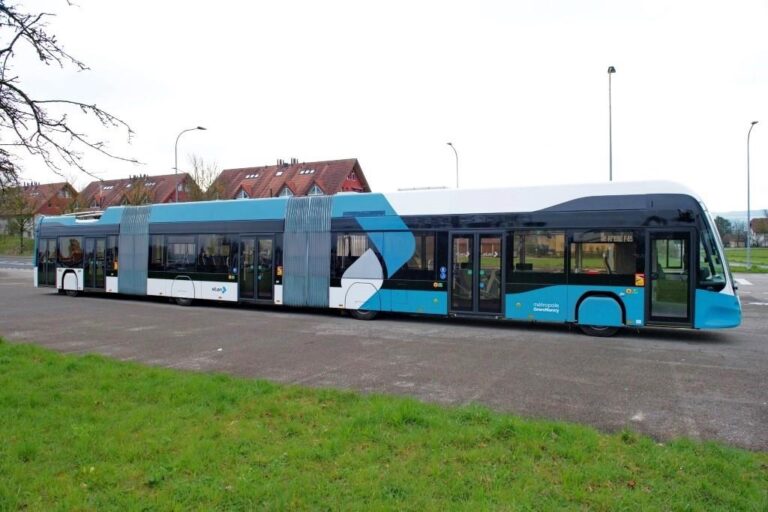Nancy Embraces Sustainable Transport with New Trolleybuses: 25 Maxi Vehicles Set for 2024
Nancy, a city known for its rich history and vibrant culture, is making a significant move towards sustainable urban mobility with the introduction of 25 maxi trolleybuses, set to hit the streets in 2024. As public transportation demands evolve, local authorities have opted for the environmentally friendly alternative of trolleybuses over traditional trams, marking a bold shift in the city’s transport strategy. The decision to partner with Hess, a recognized leader in sustainable bus manufacturing, reflects Nancy’s commitment to reducing its carbon footprint while enhancing public transport efficiency. With this transition, Nancy aims to improve connectivity, decrease traffic congestion, and promote greener commuting options for its residents.
Tram Alternatives Gaining Traction in Nancy’s Urban Transit Plans
The city of Nancy is embracing a significant shift in its transit approach, prioritizing the introduction of trolleybuses over traditional tram systems. This forward-thinking move, led by the partnership with Hess, is expected to bolster urban mobility while maintaining a commitment to sustainability. The procurement of 25 maxi trolleybuses slated for delivery in 2024 is set to enhance the public transportation network, offering an eco-friendly alternative that resonates with the city’s green ambitions.
As urban areas increasingly seek solutions to reduce congestion and pollution, NancyŌĆÖs decision reflects a broader trend in sustainable transit options. The advantages of trolleybuses include lower operational costs, flexibility in routing, and the ability to operate on existing roadways without the need for extensive rail infrastructure. Key features of the upcoming trolleybus fleet include:
- Reduced greenhouse gas emissions
- Improved energy efficiency
- Enhanced passenger comfort
| Feature | Benefit |
|---|---|
| Environmental Impact | Lower emissions compared to diesel buses |
| Operational Costs | Reduced maintenance needs |
| Urban Integration | Compatible with existing infrastructure |
City Officials Embrace Trolleybuses for Sustainable Public Transport
In a groundbreaking move towards sustainable urban transport, city officials in Nancy have announced their decision to implement a fleet of trolleybuses in collaboration with Hess, boosting the city’s commitment to eco-friendly public transit. As part of this initiative, 25 state-of-the-art maxi trolleybuses are slated for delivery in 2024, promising to enhance connectivity while reducing the carbon footprint. This shift marks a significant departure from traditional trams, as trolleybuses offer greater flexibility in routing and reduced infrastructure costs.
The decision has garnered widespread support, particularly among environmental advocates and urban planners. Key benefits of trolleybus systems include:
- Lower Emissions: Operating on electric power significantly reduces greenhouse gas emissions.
- Cost-Effective: Trolleybuses require less investment in infrastructure compared to trams.
- Increased Mobility: They can easily navigate through densely populated areas, enhancing accessibility.
| Feature | Trolleybuses | Trams |
|---|---|---|
| Environmental Impact | Low emissions | Higher emissions |
| Infrastructure Needs | Minimal | Extensive |
| Operational Flexibility | High | Low |
Hess to Supply Nancy with a Fleet of Eco-Friendly Maxi Vehicles
The city of Nancy is set to revolutionize its public transport system with the introduction of 25 eco-friendly maxi trolleybuses supplied by Hess, aimed at enhancing urban mobility while reducing carbon emissions. Slated for delivery in 2024, these state-of-the-art vehicles will operate across the city, replacing traditional tram services and promoting a greener alternative for daily commuters. The decision underscores Nancy’s commitment to sustainable transport solutions, paving the way for a more efficient and environmentally responsible transit network.
These maxi vehicles feature advanced technology designed for optimal performance while minimizing energy consumption. Key attributes include:
- Zero-emission operation to combat air pollution
- Enhanced passenger capacity for increased ridership
- Smart technology integration for real-time tracking and scheduling
In accordance with Nancy’s urban development goals, Hess has prioritized sustainability in these vehicles’ design, promising a cleaner environment for all. With the 2024 rollout, residents can expect an improved transit experience, fostering greater use of public transportation and contributing to the city’s efforts toward a more sustainable future.
Future of Urban Mobility: Recommendations for Successful Integration
The city of Nancy is set to revolutionize its public transportation system with the integration of 25 new maxi trolleybuses from Hess, scheduled for deployment in 2024. This shift away from traditional tram systems underscores a commitment to sustainable urban mobility that emphasizes efficiency and reduced emissions. Trolleybuses, which draw power from overhead wires, offer the dual benefit of lower operational costs and a significant decrease in carbon footprint compared to diesel-powered alternatives. This move not only aligns with global sustainability goals but also enhances the urban landscape, promoting cleaner, quieter neighborhoods.
To ensure the successful integration of these vehicles, city planners and stakeholders should consider several key factors:
- Infrastructure Upgrades: Investing in necessary facilities for maintenance and charging.
- Public Engagement: Conducting outreach programs to educate residents about the benefits of trolleybuses.
- Regulatory Support: Securing policies that favor electric public transport systems.
- Data-Driven Decision Making: Implementing real-time data to monitor and optimize routes.
Collaborative efforts and a focus on these areas will be critical in ensuring the trolleybus system meets the needs of the community while setting a precedent for future urban mobility projects.
In Conclusion
In conclusion, NancyŌĆÖs decision to pivot from trams to trolleybuses marks a significant shift in the cityŌĆÖs approach to sustainable public transport. With the introduction of 25 new maxi vehicles in 2024, residents can anticipate not only improved mobility but also a reduction in environmental impact. This transition underscores the growing recognition of trolleybuses as a viable alternative that combines efficiency with sustainability. As the city embraces this innovative solution, it sets a precedent for others looking to modernize their public transport systems amid rising environmental concerns. As we move forward, the eyes of the transport community will be on Nancy, eager to see the successful integration of these vehicles into the urban landscape.




